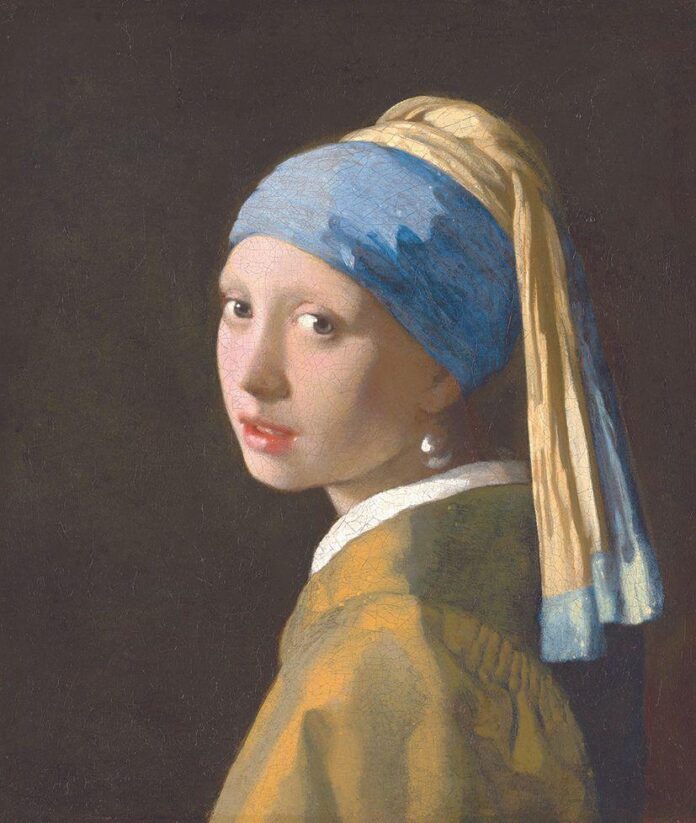Coinciding with its current Vermeer retrospective (until 4 June), the Rijksmuseum held a symposium in Amsterdam on 28-29 March, bringing together specialists from around the world. This offered an unusual opportunity to share the latest developments in Vermeer scholarship. In a field that has been thoroughly researched over the past 30 years, it is astonishing that so much new information emerged. Last week, we revealed the discovery of a probable self-portrait, hidden beneath paint in A Maid Asleep. Here we present some more of the most important discoveries.
Girl with a Pearl Earring—in 100 billion pixels
Vermeer’s most popular painting, Girl with a Pearl Earring (around 1664-67, Mauritshuis, The Hague), has been reexamined using the latest scientific techniques. The results, which are being analysed by the conservator Abbie Vandivere and an international team, will be presented to visitors in a display opening on 8 June, entitled Who’s that Girl?
We can report that state-of-the-art imaging, including 3D digital microscopy, has produced an image made with over 100 billion pixels. Online viewers will be able to zoom in and see enormous detail, with even individual pigment particles visible. A four-metre-high 3D image of the painting will be shown in the Mauritshuis foyer.
Computer scientists are also working on a digital visualisation of how the painting might have looked when it left the artist’s easel. Behind the girl, Vermeer originally painted a green curtain, but the blue and yellow pigments have faded, leaving the present greyish-black plain background.
There have also been colour changes to the shadows on the right side of the girl’s headscarf. These would originally have appeared warmer in tone, making the rounded form of her head more realistic. Her face would have been redder, particularly in the shadows. So the girl would have appeared more vivid and three-dimensional.
As for the pearl, Vandivere describes it as “an illusion—it has no contour—and also no hook to hang it from the girl’s ear: it’s just a few brushstrokes of lead white.” We recently reported on our website that a pearl this size would have been astronomically expensive, speculating that the girl may well be depicted with a glass bauble.

Top to bottom: Detail from Allegory of Catholic Faith (around 1670-74) / A photo of the 1640 edition of Legende der Heylighen (legends of the saints) by Pedro Ribadineira and Heribert Rosweyde
Metropolitan Museum of Art / —-
A page in a book identified
Evelyne Verheggen, a University of Antwerp researcher, has identified the open book that appears in Vermeer’s Allegory of the Catholic Faith (around 1670-74, Metropolitan Museum of Art, New York, below). It is the 1640 edition of Legende der Heylighen (legends of the saints) by Pedro Ribadineira and Heribert Rosweyde (left, top: a detail from the painting; left, bottom: a photo of the book).
She was also able to identify the page it is opened to in the painting, p.546, which includes the text on Hugo of Lincoln, who died in 1200. Hugo is venerated on 17 November, which happens to be the date when the French army was forced to withdraw from Utrecht in 1673. If indeed there is a link with the Hugo page, as Verheggen suspects, then the dating of the painting should arguably be narrowed down from 1670-74 to late 1673 or 1674. Verheggen believes that the subject matter of Vermeer’s painting is not “faith” (as reflected in its traditional title), but more specifically Mary Magdalene. She sees the figure of the woman as representing the Magdalene, “a personification of the devout Catholic women, praying”.

Vermeer’s Allegory of the Catholic Faith (around 1670-74)
The Metropolitan Museum of Art, New York
Vermeer’s female patron
In February The Art Newspaper revealed that Vermeer’s main patron was a woman: Maria van Ruijven, rather than her husband Pieter. We can now report further evidence, presented at the symposium by Judith Noorman, a University of Amsterdam art historian.
The document is a 1664 codicil to Maria’s will. It was already known that a year later she bequeathed 500 guilders to Vermeer. But the newly discovered record shows that the bequest was more longstanding.
The codicil, discovered in the Leiden archives, is important for another reason: Maria gave one painting “of his own choice” to a friend, Nicolaes van Assendelft. Maria and Nicolaes seem to have shared a mutual love of art.
Noorman, who is researching women’s impact on the Dutch art market, told the symposium: “The reason why Maria has been overlooked and why Pieter has received most of the attention, is because he, as a man, was easier to place and understand in a man’s world.”
A new Vermeer document
A Dutch scholar, Rozemarijn Landsman (from New York’s Columbia University), has just discovered a previously unknown archival document with Vermeer’s signature. This relates to the bequest of land to the artist’s wife Catharina Bolnes. Full details will be published in Landsman’s forthcoming article in the art history journal Oud Holland. With Vermeer, every archival reference is important.

The Philadelphia version of Lady Playing Guitar.
Philadelphia Museum of Art
Is Philadelphia’s Guitar Player a 38th Vermeer?
Arie Wallert, a former Rijksmuseum scientific specialist, told the symposium about his investigations into another version of The Guitar Player (the universally accepted version, of around 1670-72, is at Kenwood, in London). The other version (above) is at the Philadelphia Museum of Art, where it has been languishing in store since it was downgraded in 1927.
As The Art Newspaper reported on its website in April, Wallert believes his technical examination suggests that the Philadelphia painting is not only a 17th-century work, but is actually “a painting by Vermeer”. The two compositions are virtually the same, except for one key difference, the guitar player’s hairstyle.
Sasha Suda, the director of the Philadelphia museum, comments: “The future of our Lady with a Guitar will be to inspire discussion, embracing scholarship, and to seek more knowledge and enlightenment from this mysterious painting nearly 350 years after its creation”.

























